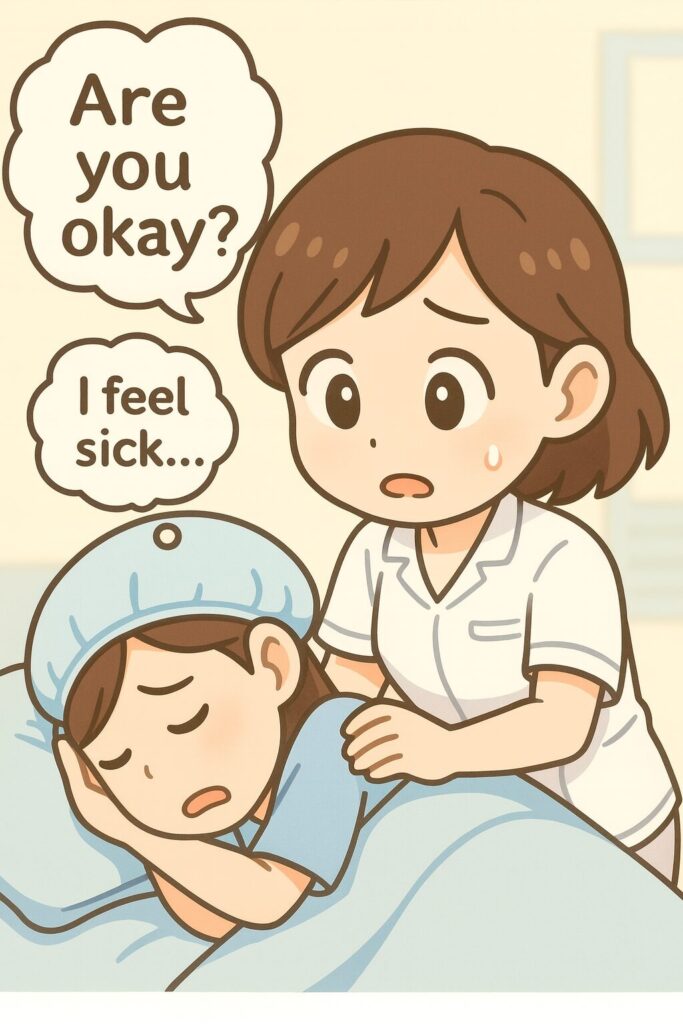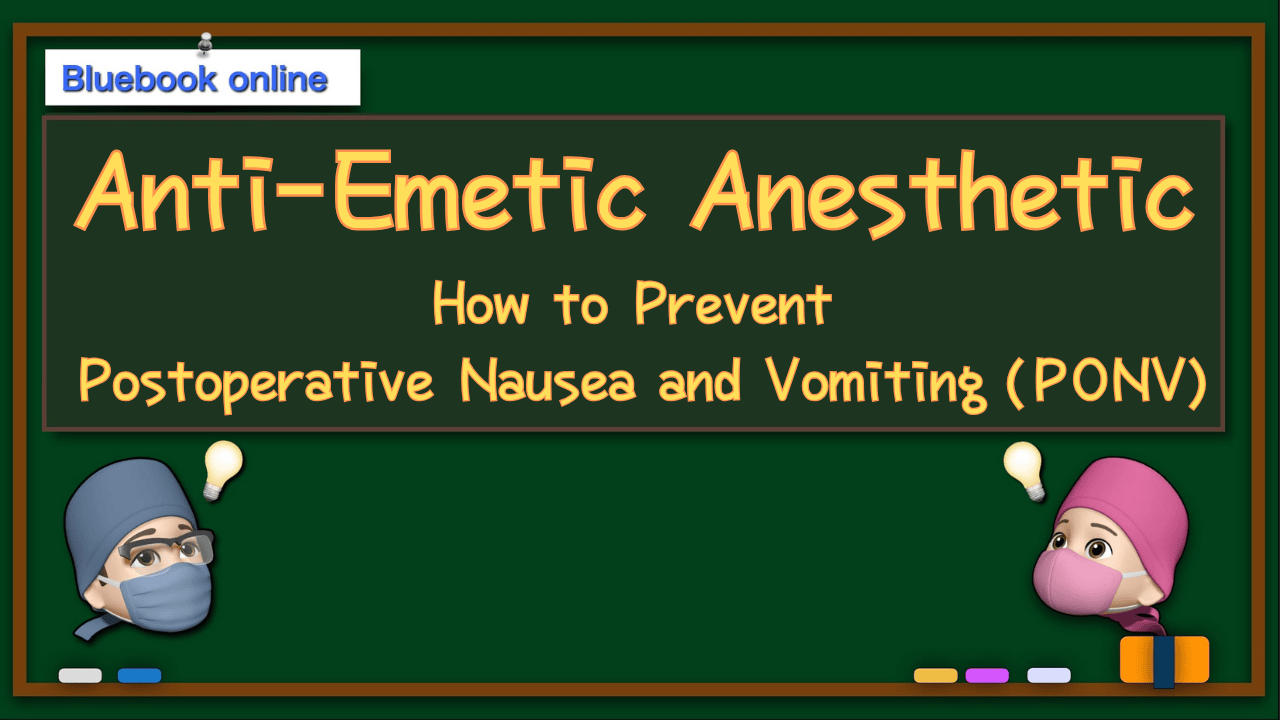👉👉 🇺🇸 All Posts 🇬🇧 / 🇯🇵 記事一覧 🇯🇵 👈👈
♦️ Introduction
After anesthesia, when the surgery is over and everything seems fine, the patient suddenly murmurs,
That distressing moment is PONV — postoperative nausea and vomiting.
Without prophylaxis, it occurs in about 30% of all surgical patients under general anesthesia,
and in up to 80% of high-risk patients.
It’s one of the leading causes of postoperative discomfort and dissatisfaction — along with shivering and pain.
The good news: with evidence-based prevention, PONV can be dramatically reduced.

♦️ Step1:Quantify the Risk — The Apfel Score
🔷 Apfel Score
| Risk Factor | Description |
|---|---|
| 👩 Female sex | About 2–3× higher risk than males |
| 🚭 Non-smoker | Smoking appears to have a protective effect |
| 🤢 History of PONV or motion sickness | Indicates individual susceptibility |
| 💊 Postoperative opioid use | Potent trigger for nausea/vomiting |
| Total Apfel Score | Estimated PONV risk |
|---|---|
| 0 | ≈10% |
| 1 | ≈20% |
| 2 | ≈40% |
| 3 | ≈60% |
| 4 | ≈80% |
💡 Interpretation:
- 0–1 = low risk (single agent often sufficient)
- 2 = moderate risk (dual prophylaxis)
- ≥3 = high risk (multimodal approach: ≥3 agents)
The Apfel score remains the most widely used global standard and is reaffirmed in the Fourth Consensus Guidelines (Gan TJ et al., Anesth Analg 2020).
📖 Apfel CC, Laara E, Koivuranta M, Greim CA, Roewer N.
A simplified risk score for predicting postoperative nausea and vomiting: conclusions from cross-validations between two centers.
Anesthesiology. 1999;91:693–700.
🔷 Pediatric Variant — The POVOC Score
| Factor | Description |
|---|---|
| ⏱ Surgery duration ≥ 30 min | Longer procedures raise risk |
| 👦 Age ≥ 3 years | Older children more susceptible |
| 👁 Strabismus surgery | High-risk category |
| 👨👩👧 Family or patient history of PONV/motion sickness | Genetic tendency |
📖 Eberhart LHJ et al. Anesth Analg. 2004;99:1630–1637.
♦️ Step 2: Lower the Baseline Risk — “Make the Anesthetic Less Emetic”
Before adding drugs, optimize the anesthetic technique itself:
- 🌿 Use total intravenous anesthesia (TIVA) with propofol → Reduces PONV 3–5-fold compared with volatile agents.
- ❌ Avoid nitrous oxide when possible.
- 💉 Minimize opioids (multimodal analgesia: acetaminophen, NSAIDs, regional blocks).
- 💧 Adequate IV hydration.
- ⚙️ Avoid large doses of neostigmine; consider sugammadex for reversal.
✅ These baseline adjustments often halve PONV incidence before pharmacologic prophylaxis.
💊 Step 3: Pharmacologic Prophylaxis — Evidence-Based Regimens
🌎 Global standard (per 2020 Consensus):
Combine drugs with different mechanisms for additive protection.
Base the number of agents on risk level (Apfel score).
| Drug | Recommended Timing | Typical Dose | Notes |
|---|---|---|---|
| Dexamethasone | Induction | 4–8 mg IV | Cornerstone agent; early administration more effective. |
| Ondansetron | End of surgery | 4 mg IV | Most widely used 5-HT₃RA; 8 mg oral ODT also effective. |
| Granisetron | End of surgery | 0.35–3 mg IV | Slightly longer half-life. |
| Palonosetron | End of surgery | 0.075 mg IV | Long-acting; useful for PDNV prevention. |
| Droperidol | End of surgery | 0.625 mg IV | Highly effective; monitor QTc. |
| Haloperidol | End of surgery | 0.5–1 mg IV | Alternative when droperidol unavailable. |
| Aprepitant (NK₁RA) | Induction | 40 mg PO | Long-acting; prevents vomiting > nausea. |
| Transdermal scopolamine | Evening before → 2 h preop | 1 patch | FDA-approved; useful for outpatients. |
💡 Preferred combinations
- Moderate risk (2 factors): dexamethasone + 5-HT₃RA
- High risk (≥3 factors): dexamethasone + 5-HT₃RA + NK₁RA or scopolamine or droperidol
🇯🇵 In Japan: ondansetron, granisetron, and palonosetron are now officially approved for PONV, whereas dexamethasone use remains off-label.
🚨 Step4:Rescue Treatment — If PONV Occurs
Even with optimal prophylaxis, breakthrough PONV can happen.
Key rule:
- If prophylaxis included a 5-HT₃RA → use droperidol, haloperidol, or promethazine.
- If dexamethasone alone was given → use a 5-HT₃RA.
- Re-dosing the same class within 6 hours is usually ineffective.
🇺🇸 In the U.S., amisulpride (Barhemsys) is now FDA-approved for both prophylaxis and rescue of PONV (5 mg IV for prevention, 10 mg IV for rescue), following failure of other classes.
(Not yet widely approved in Asia.)
🕒 Step 5:Don’t Forget PDNV — Post-Discharge Nausea and Vomiting
Especially relevant for ambulatory surgery. Five PDNV risk factors:
- Female sex
- Age < 50 years
- Prior PONV or motion sickness
- Nausea in PACU
- Opioid use in PACU
| PDNV score | Estimated incidence |
|---|---|
| 0–1 | 10–20% |
| 2–3 | 30–50% |
| 4–5 | 60–80% |
Use long-acting antiemetics (palonosetron, aprepitant, scopolamine TTS) when PDNV risk is high.
Outpatient follow-up instructions should include hydration and rescue antiemetic guidance.
📖 Apfel CC et al., Anesth Analg 2012.
📝 Summary: Take Home Points
- ✅ Quantify risk: Apfel (adults), POVOC (children), PDNV score (outpatients).
- ✅ TIVA + opioid-sparing + hydration = first-line risk reduction.
- ✅ Use multimodal prophylaxis — combine agents with different mechanisms.
- ✅ Dexamethasone (induction) + 5-HT₃RA (end of case) = evidence-based core.
- ✅ For high-risk patients, add NK₁RA, droperidol, or scopolamine.
- ✅ Rescue with a different class if symptoms occur within 6 hours.
- ✅ Plan for PDNV in outpatients with long-acting drugs.
📚 References & Further reading
- Gan TJ et al. Fourth Consensus Guidelines for the Management of PONV. Anesth Analg. 2020.
- Apfel CC et al. A simplified risk score for predicting PONV. Anesthesiology. 1999.
- Eberhart LHJ et al. POVOC: Pediatric risk score. Anesthesiology. 2004.
- Apfel CC et al. PDNV risk factors. Anesth Analg. 2012.
- Elvir-Lazo OL, White PF. TIVA and PONV reduction. Anesth Analg. 2020.
- FDA labeling: Barhemsys (amisulpride) Package Insert, U.S. 2020.

コメントを投稿するにはログインしてください。